| Years in Poland: | 1769 1770 1771 1772 1773 1774 1775 |
| Centuries: | 17th century · 18th century · 19th century |
| Decades: | 1740s 1750s 1760s 1770s 1780s 1790s 1800s |
| Years: | 1769 1770 1771 1772 1773 1774 1775 |

Events from the year 1772 in Poland
| Years in Poland: | 1769 1770 1771 1772 1773 1774 1775 |
| Centuries: | 17th century · 18th century · 19th century |
| Decades: | 1740s 1750s 1760s 1770s 1780s 1790s 1800s |
| Years: | 1769 1770 1771 1772 1773 1774 1775 |

Events from the year 1772 in Poland
| | This section needs expansion. You can help by adding to it. (October 2015) |
| | This section needs expansion. You can help by adding to it. (October 2015) |
| | This section needs expansion. You can help by adding to it. (October 2015) |

The Partitions of Poland were three partitions of the Polish–Lithuanian Commonwealth that took place toward the end of the 18th century and ended the existence of the state, resulting in the elimination of sovereign Poland and Lithuania for 123 years. The partitions were conducted by the Habsburg monarchy, the Kingdom of Prussia, and the Russian Empire, which divided up the Commonwealth lands among themselves progressively in the process of territorial seizures and annexations.
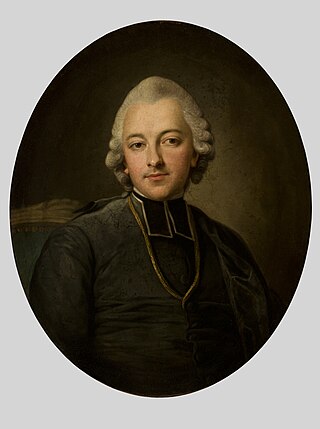
Ignacy Błażej Franciszek Krasicki, from 1766 Prince-Bishop of Warmia and from 1795 Archbishop of Gniezno, was Poland's leading Enlightenment poet, a critic of the clergy, Poland's La Fontaine, author of the first Polish novel, playwright, journalist, encyclopedist, and translator from French and Greek.
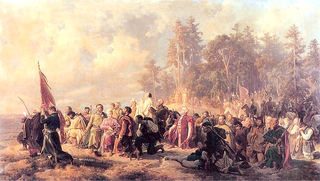
The Bar Confederation was an association of Polish–Lithuanian nobles (szlachta) formed at the fortress of Bar in Podolia, now Ukraine, in 1768 to defend the internal and external independence of the Polish–Lithuanian Commonwealth against Russian political influence and against King Stanislaus II Augustus with Polish reformers, who were attempting to limit the power of the Commonwealth's wealthy magnates.
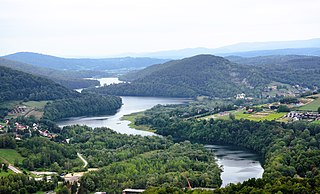
The San is a river in southeastern Poland and western Ukraine. It is a tributary of the river Vistula. With a length of 458 kilometres (285 mi), the San is the 6th-longest Polish river. It has a basin area of 16,877 km2, of which 14,426 km2 is in Poland.

Tuczno is a town and former pre-diocesan Catholic see in Wałcz County, West Pomeranian Voivodeship in northwestern Poland, with 2,014 inhabitants (2004).

Galicia is a historical and geographic region spanning what is now southeastern Poland and western Ukraine, long part of the Polish–Lithuanian Commonwealth. It covers much of the other historic regions of Red Ruthenia and Lesser Poland.

A Treaty of Perpetual Peace between the Tsardom of Russia and the Polish–Lithuanian Commonwealth was signed on 6 May 1686 in Moscow by Polish–Lithuanian Commonwealth envoys: voivod of Poznań Krzysztof Grzymułtowski and chancellor (kanclerz) of Lithuania Marcjan Ogiński and Russian knyaz Vasily Vasilyevich Golitsyn. These parties were incited to cooperate after a major geopolitical intervention in Ukraine on the part of the Ottoman Empire.
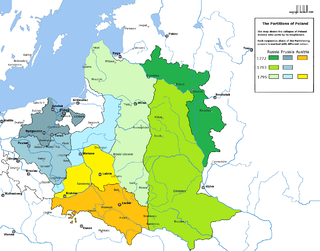
The Third Partition of Poland (1795) was the last in a series of the Partitions of Poland–Lithuania and the land of the Polish–Lithuanian Commonwealth among Prussia, the Habsburg monarchy, and the Russian Empire which effectively ended Polish–Lithuanian national sovereignty until 1918. The partition was the result of the Kościuszko Uprising and was followed by a number of Polish–Lithuanian uprisings during the period.

The Chełmno Voivodeship was a unit of administrative division and local government in the Kingdom of Poland since 1454/1466 until the Partitions of Poland in 1772/1793. Its capital was at Chełmno.

Dobromyl is a city in Sambir Raion, Lviv Oblast, Ukraine. It is located some 5 kilometers from the border with Poland. It hosts the administration of Dobromyl urban hromada, one of the hromadas of Ukraine. Population: 4,111.

Dudyńce is a village in East Małopolska in the Beskid mountains, Bukowsko rural commune. Dudyńce is located near the town of Sanok, and near the towns of Dukla and Palota.
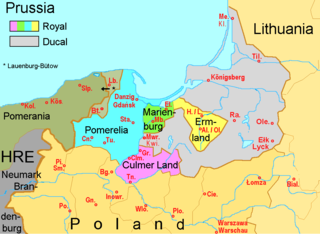
Lauenburg and Bütow Land formed a historical region in the western part of Pomerelia or in the eastern part of Farther Pomerania. It was composed of two districts centered on the towns of Lauenburg (Lębork) and Bütow (Bytów). The land is today part of the Polish Pomeranian Voivodeship.

The Prussian Partition, or Prussian Poland, is the former territories of the Polish–Lithuanian Commonwealth acquired during the Partitions of Poland, in the late 18th century by the Kingdom of Prussia. The Prussian acquisition amounted to 141,400 km2 of land constituting formerly western territory of the Commonwealth. The first partitioning led by imperial Russia with Prussian participation took place in 1772; the second in 1793, and the third in 1795, resulting in Poland's elimination as a state for the next 123 years.

The First Partition of Poland took place in 1772 as the first of three partitions that eventually ended the existence of the Polish–Lithuanian Commonwealth by 1795. The growth of power in the Russian Empire threatened the Kingdom of Prussia and the Habsburg monarchy and was the primary motive behind the First Partition.
Franciszkowo is a village in the administrative district of Gmina Złotów, within Złotów County, Greater Poland Voivodeship, in west-central Poland. It lies approximately 8 kilometres (5 mi) north-west of Złotów and 113 km (70 mi) north of the regional capital Poznań.

Szymankowo is a village in the administrative district of Gmina Lichnowy, within Malbork County, Pomeranian Voivodeship, in northern Poland. It lies approximately 5 kilometres (3 mi) south of Lichnowy, 9 km (6 mi) north-west of Malbork, and 38 km (24 mi) south-east of the regional capital Gdańsk.
Kołpaki is a settlement in the administrative district of Gmina Purda, within Olsztyn County, Warmian-Masurian Voivodeship, in northern Poland. It lies approximately 9 kilometres (6 mi) west of Purda and 10 km (6 mi) south-east of the regional capital Olsztyn. It is located in Warmia.

Ostrzeszewo is a village in the administrative district of Gmina Purda, within Olsztyn County, Warmian-Masurian Voivodeship, in northern Poland. It is located within the historic region of Warmia.
Zaborowo is a settlement in the administrative district of Gmina Purda, within Olsztyn County, Warmian-Masurian Voivodeship, in northern Poland. It lies approximately 5 kilometres (3 mi) south-east of Purda and 20 km (12 mi) south-east of the regional capital Olsztyn.
![]() Media related to 1772 in Poland at Wikimedia Commons
Media related to 1772 in Poland at Wikimedia Commons